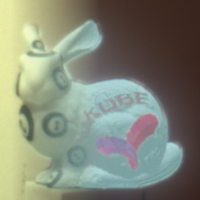Emerging Technologies Talk
|
FCFull Conference Pass (FC - All Days)
FC1Full Conference Pass (FC - 1-Day Only)
BCBasic Conference Pass
ExExhibits Only
ETElectronic Theater Ticket
RTReception Ticket
|

Diminishable Visual Markers on Fabricated Projection Object for Dynamic Spatial Augmented Reality
We propose a novel marker embedding method for position and pose estimation of a dynamically moving projection surface for spatial augmented reality. In our method, visual markers are directly embedded on a 3D projection surface which is printed out from a digital fabrication machine, in particular, full-color 3D printer. Since the markers automatically embedded on a surface with mechanical accuracy, more precise geometric registration is achieved than conventional method. However, the shape of markers printed on a non-planar surface is possibly deformed, which potentially decreases the performance of vision-based marker recognition. In addition, the marker itself is visually salient, and consequently, disturbs a user’s sense of immersion. To solve these issues, we designed the marker’s shape and decided its reflectance. Moreover, we proposed a novel marker placement method.
The shape of a marker is designed so that its center is detected even when it is printed on a non-planar surface. To realize a robust center detection, we apply a checker corner for the center of the marker, which can be detected with sub-pixel accuracy. We also apply a donut-shaped frame to increase the robustness for image noise. The reflectance of the marker is decided so that the markers become invisible by projections and can be detected. We make the markers invisible by applying a radiometric compensation technique, which corrects each projected pixel color so that desired projected colors appear on the markers. The marker placement is computed by using Genetic Algorithm to maximize the number of observable markers from various viewpoints for stable position/pose estimation, where a location of each marker represents a gene.
Experimental result shows that our method can estimate the position/pose of a printed projection surface accurately while visually canceling the markers by projection.
Presenter(s)
Hirotaka Asayama,Osaka University
Daisuke Iwai,Osaka University
Kosuke Sato,Osaka University

